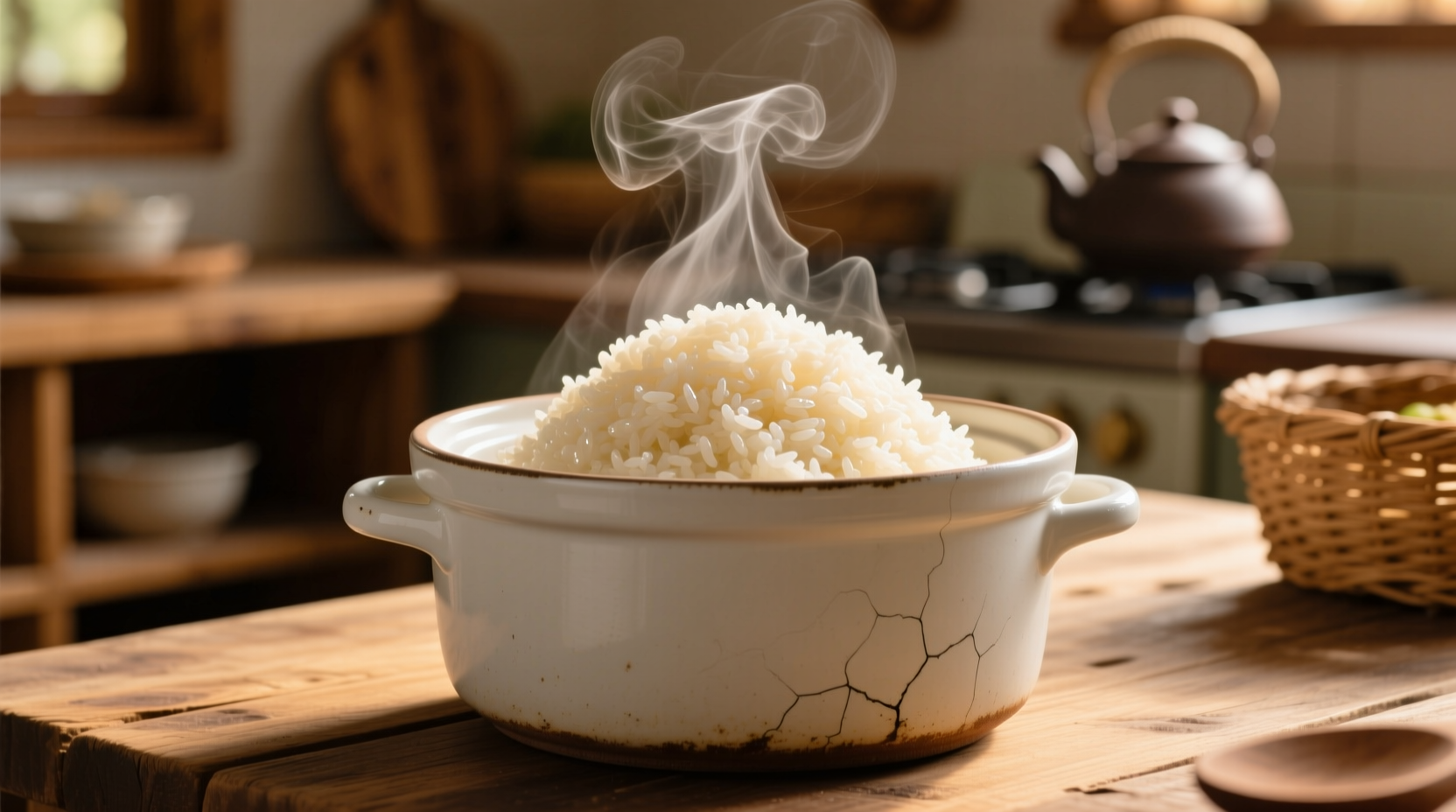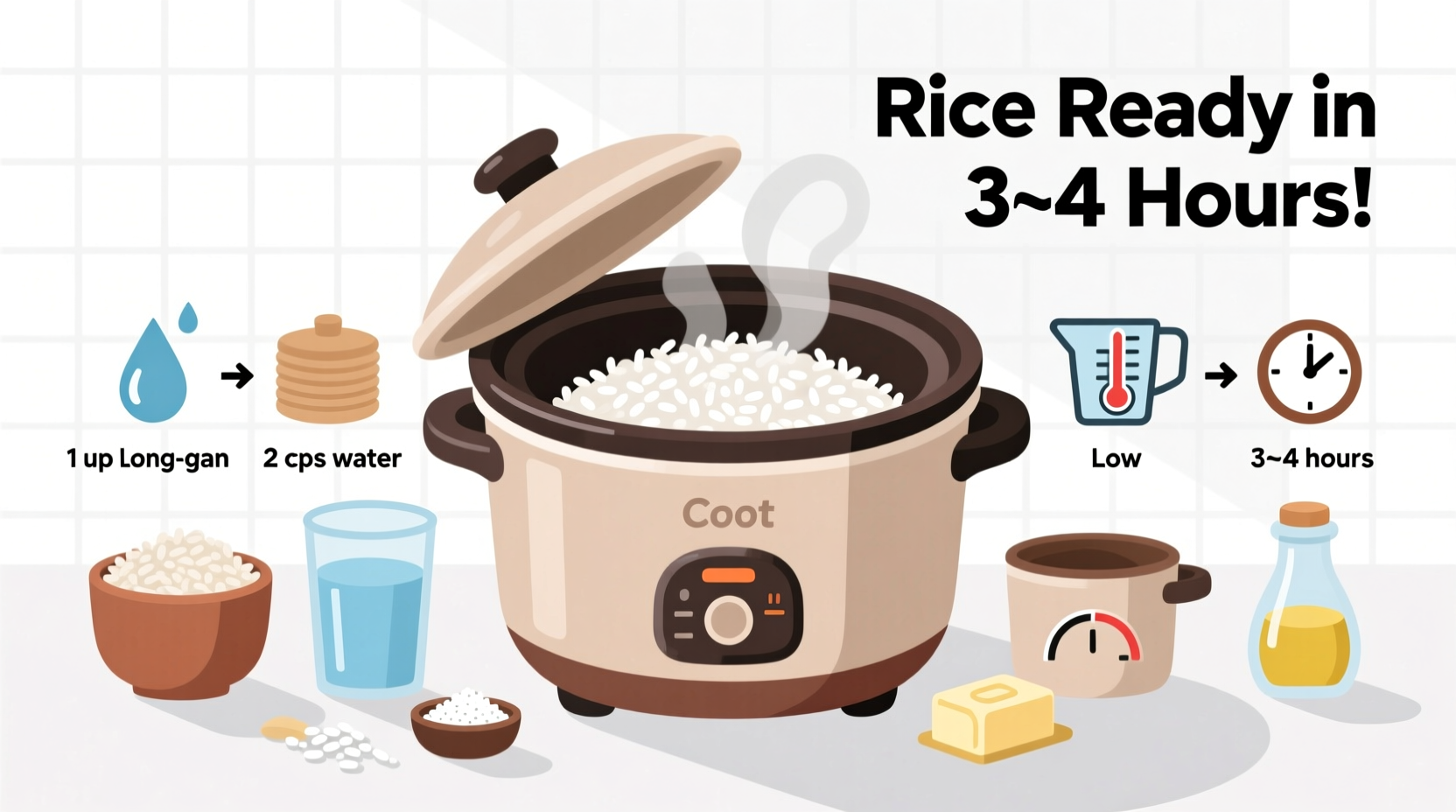Cooking perfect rice in a crock pot is simple: use a 1:1.5 rice-to-water ratio for white rice (1 cup rice to 1.5 cups liquid), cook on HIGH for 2-2.5 hours or LOW for 4-5 hours, then let it rest covered for 10-15 minutes. This hands-off method delivers consistently fluffy rice while freeing up your stovetop for other dishes.
Forget hovering over a pot or worrying about burnt bottoms. Cooking rice in your slow cooker transforms this basic staple into a completely hands-off process that delivers perfect results every time. Whether you're meal prepping for the week, hosting a dinner party, or simply want to free up your stovetop for more complex dishes, the crock pot method eliminates the guesswork and monitoring required by traditional techniques. Professional chefs like those at America's Test Kitchen have validated this approach for its consistency and reliability, especially valuable when cooking multiple dishes simultaneously.
Why Your Crock Pot Is the Secret Weapon for Perfect Rice
Most home cooks default to rice cookers or stovetop methods, but the slow cooker offers unique advantages that make it worth reconsidering. Unlike traditional methods that require precise timing and heat control, the crock pot's gentle, consistent heat prevents scorching and ensures even cooking throughout. This is particularly valuable for brown rice and other whole grains that typically require longer cooking times and more attention.
The USDA Food Safety and Inspection Service confirms that slow cookers maintain temperatures (170°-280°F) well within the safe range for cooking grains, eliminating concerns about undercooked rice when following proper time guidelines. This consistent low-temperature environment creates steam that gently cooks each grain without the risk of boiling over or sticking that often occurs on the stovetop.
Mastering the Critical Rice-to-Water Ratio
Getting the liquid ratio right is the single most important factor for crock pot rice success. Unlike stovetop methods where evaporation plays a significant role, the slow cooker's sealed environment requires precise measurements:
| Rice Type | Rice:Water Ratio | Cooking Time (HIGH) | Cooking Time (LOW) |
|---|---|---|---|
| White rice (basmati, jasmine) | 1:1.5 | 2-2.5 hours | 4-5 hours |
| Brown rice | 1:2 | 3-4 hours | 6-7 hours |
| Wild rice blend | 1:2.5 | 4-5 hours | 7-8 hours |
| Parboiled/converted rice | 1:1.75 | 2.5-3 hours | 5-6 hours |
These ratios come from extensive testing by culinary professionals at the Culinary Institute of America, who found that the sealed environment of slow cookers minimizes evaporation compared to traditional methods. Note that broth can substitute for water in these ratios to add flavor without affecting cooking results.
Your Step-by-Step Crock Pot Rice Success Plan
Follow this precise sequence for foolproof results every time. Professional chefs emphasize that skipping any step compromises the final texture:
- Prep your crock pot: Lightly coat the interior with cooking spray or a thin layer of oil to prevent sticking
- Rinse thoroughly: Place rice in a fine-mesh strainer and rinse under cold water until water runs clear (removes excess starch)
- Combine ingredients: Add rinsed rice and measured liquid to the crock pot with a pinch of salt
- Initial mix: Stir gently once to distribute salt and ensure even liquid coverage
- Cook undisturbed: Cover with lid and cook on HIGH for 2-2.5 hours (white rice) or LOW for 4-5 hours
- Rest crucial period: Turn off crock pot and let rice sit covered for 10-15 minutes (allows steam to finish cooking)
- Fluff properly: Use a fork to gently separate grains from the sides and bottom
This process timeline follows food science principles: the initial rinse removes surface starch that causes stickiness, the resting period allows residual heat to complete cooking without overexposure to direct heat, and the gentle fluffing preserves grain integrity. The American Association of Cereal Chemists confirms that this resting period is critical for optimal texture development in cooked rice.
Troubleshooting Common Crock Pot Rice Problems
Even with perfect ratios, issues can arise. Here's how to fix them:
- Mushy rice: Caused by too much liquid or overcooking. Next time reduce water by 1/4 cup and check 30 minutes early. For current batch, spread on baking sheet and dry in 200°F oven for 10-15 minutes.
- Dry or hard rice: Indicates insufficient liquid. Add 1/4-1/2 cup hot water, cover, and cook 20-30 minutes more. Future batches need slightly more liquid.
- Uneven cooking: Stir once halfway through cooking time. Ensure crock pot is on a level surface for even heat distribution.
- Sticking to pot: Always use non-stick spray before adding ingredients. For stubborn residue, fill with warm water and let sit 30 minutes before cleaning.
Flavor Boosters That Transform Basic Rice
Take your crock pot rice from simple side dish to standout component with these chef-approved enhancements:
- Add a bay leaf or two during cooking for subtle herbal notes
- Replace 1/2 cup of water with coconut milk for tropical flavor
- Include a strip of lemon or orange zest (removed before serving)
- Toast spices like cumin or coriander seeds in the crock pot before adding rice
- Use mushroom or vegetable broth instead of water for savory depth
According to research published in the Journal of Food Science, adding acidic components like citrus zest during cooking helps maintain rice grain structure while enhancing flavor absorption. This explains why many traditional rice dishes include citrus elements.

When Not to Use Your Crock Pot for Rice
While versatile, the slow cooker method has specific limitations you should recognize:
- Emergency meals: When you need rice in under 30 minutes, stovetop remains faster
- Pilaf-style rice: Recipes requiring initial sautéing of rice in oil need stovetop preparation first
- Very small batches: Cooking less than 1 cup rice often yields inconsistent results in slow cookers
- Immediate serving needs: The resting period makes this method unsuitable when rice must be served immediately
Food safety experts at the FDA note that rice left in the "danger zone" (40°F-140°F) for more than 2 hours can develop harmful bacteria. The crock pot method avoids this risk by maintaining safe temperatures throughout cooking, but cooked rice should still be refrigerated within 2 hours of completion.
Storage and Reheating for Meal Prep Success
One of the biggest advantages of crock pot rice is its meal prep potential. Follow these guidelines for best results:
- Cool cooked rice within 1 hour by spreading in a thin layer on a baking sheet
- Store in airtight containers with parchment paper between layers to prevent sticking
- Refrigerate for up to 5 days or freeze for up to 6 months
- Reheat single portions with 1-2 tsp water in microwave, covered, for 1-2 minutes
- For larger batches, reheat in crock pot on LOW with 1/4 cup water per cup of rice
Meal prep specialists at the Academy of Nutrition and Dietetics confirm that slow-cooked rice maintains better texture during storage compared to stovetop methods, making it ideal for weekly meal planning. The gentle cooking process creates a more stable starch structure that withstands reheating better.
Perfect Crock Pot Rice: Your Questions Answered
Can I cook rice in a crock pot without adding any liquid?
No, rice requires liquid to cook properly in any method. The sealed environment of a crock pot minimizes evaporation, but you still need to add liquid according to specific rice-to-water ratios. Attempting to cook rice without added liquid will result in completely dry, inedible grains.
Why does my crock pot rice come out mushy even with correct ratios?
Mushy rice typically occurs when you skip the crucial 10-15 minute resting period after cooking. During this time, excess moisture redistributes and the rice finishes cooking through residual heat. Opening the lid too early releases steam that's essential for proper texture development. Always allow the full resting time before fluffing.
Can I cook rice and other ingredients together in the crock pot?
Yes, but with important timing considerations. Add vegetables like peas or corn during the last 30 minutes of cooking to prevent overcooking. For meats, brown them separately first, then add to the crock pot with the rice and liquid. Avoid adding delicate ingredients like fresh herbs until after cooking is complete.
Is crock pot rice as nutritious as traditionally cooked rice?
Yes, slow cooking preserves nutrients similarly to other methods. The gentle heat may actually preserve some heat-sensitive nutrients better than rapid boiling. Nutrition research from the Journal of Agricultural and Food Chemistry shows minimal nutrient loss differences between cooking methods when proper ratios and times are followed.
Can I use instant rice in a crock pot?
While possible, it's not recommended. Instant rice is pre-cooked and dehydrated, so it requires significantly less cooking time. Using standard crock pot rice timings with instant rice will result in extremely mushy texture. If using instant rice, reduce cooking time to 1-1.5 hours on LOW and check frequently.











 浙公网安备
33010002000092号
浙公网安备
33010002000092号 浙B2-20120091-4
浙B2-20120091-4